When you create pop-up ads, you obviously want the leads to convert into revenue. And for that, it is essential that you make pop-up ads that maximize the number of viewers. Now, if you search tips on the web for “how to create pop-up ads,” you’d mostly find techniques that are copy and design-oriented.
Well, of course, those are important, but copy and design don’t work alone. So, we are here to tell you the most effective practices to create the most effective ads ever. And don’t miss out on that one element your pop-up should 100% have.
What Are Pop-up Ads?
Pop-up ads are small windows that suddenly appear (pops-up) on the screen during an online browsing session. Usually generated using JavaScript, there is no standard size or shape of the window, and they can either appear on the landing webpage or in between loading the pages.
Pop-up Ads are an effective marketing tool for converting visitors into customers. The key feature is that the visitor needs to either click on it to do what it says or close the ad window, which increases the probability that the message in the ad is read. According to Sumo Study, the average conversion rate for pop-ups is 3.09%.
Why Are Pop-up Ads Important?
Popups ads helpful for several reasons. Let’s look at the below:
They Act As Salespersons
Ever wonder how in a grocery store, people get confused with the magnitude of choices available for a single product? And how they look for an executive to help them figure out.
Well, pop-up ads on websites are the salespersons for your business.
Visitors are distracted by multiple clickable links, messages, and buttons on a web page. But pop-up ads appear at the right time, eliminate distractions and narrow down the visitor’s attention on lucrative offers and guide them with decision making. Hence, ensuring a higher conversion rate.
Increases Brand Visibility
What does a newspaper ad right at the center of the page do?
It compels you to look at it and acquaints you with the brand.
Likewise, well-implemented pop-up ads placed at the right point (usually the center of the website) catch the visitors’ eye such that they would definitely look at the content of the ad before closing it. It enables brands and businesses to penetrate the non-traditional markets and introduce themselves to a new customer base.
Highlights The Message
When you listen to a radio ad, you might not pay much attention, but when you listen to it over and over again, it sticks with you, leaving you intrigued. This happens because of the effective frequency.
Likewise, pop-up ads on websites leverage frequency, and by showing the desired message more than once, they highlight and reinforce the message in the visitor’s mind.
Addresses Visitors’ Doubts
One of the most common reasons that visitors leave before actually completing the purchase is that they don’t find answers to certain questions. For example, whether the shipping is chargeable or free, or whether there is any discount on the products.
Pop-ups provide useful information and address visitors’ questions. This results in a reduction in the bounce rate and an increase in the conversion rate.
Here are some pop-up examples:
• The first 50 customers receive a free gift
• Free Shipping on Orders above $150
• An extra 20% promotional discount on all articles
Collects Contact Information
One of the key merits of pop-ups is to amplify your user database. Pop-ups like newsletter opt-ins and giveaways subtly collect visitor information for future use. You can later use this contact info and send messages and emails to inform people about any latest developments, discounts, or offers.
Websites with pop-up ads sweeten the pot. So, you can expect a genuine and reliable potential client database.
For example-
“A sneak-peak into the collection two days before the sale is only available to our email subscribers.”
BitNinja used pop-up ads to collect information and saw a 114% increase in the subscription.
How to Create High Converting Pop-up Ads?
If you’ve been wondering how to create effective and efficient pop-up ads, you can do it easily using various online platforms like Wishpond.
With the help of Wishpond’s popup builder, it’s easy to create popups and place them on the website, blogs, or e-commerce store. The best part? You don’t need a designer or a coder.
Here’s how to make pop up ads:
Step 1: Configuration

The first step in the pursuit of how to create pop-up ads is to create an account on Wishpond by signing up. After logging in, choose “Popup” from the “Create a New Campaign” option available on your dashboard.
Next, you’ll be redirected to a page displaying various popup design templates. Choose the one you like.
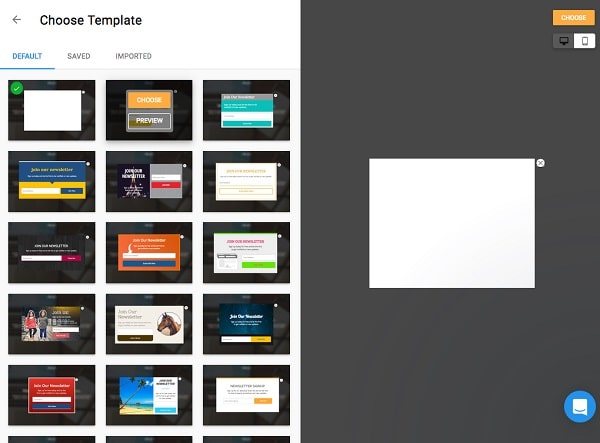
Step 2: Create your design
Once you choose your preferred popup template, click on the “+” icon on the top left corner of the editor, and add the content by dragging and dropping it over the popup.
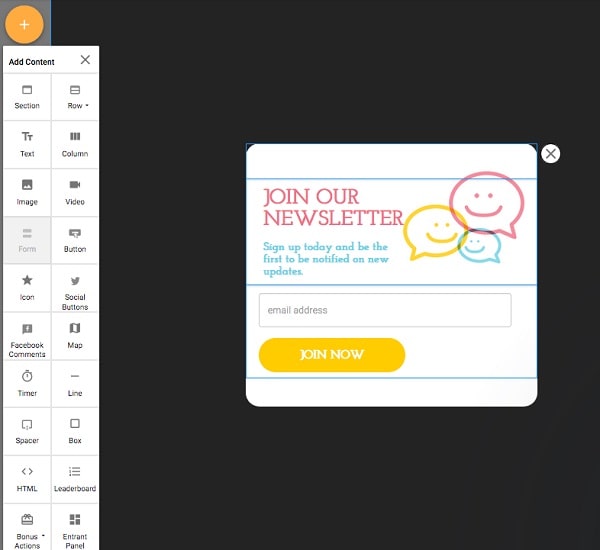
You can edit default or custom fields by clicking the bottom right icon of the fields options.
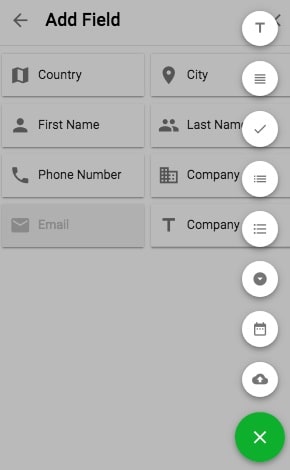
Set the background you prefer by clicking on the palette icon in the top corner of the editor.

You can choose to keep the background in a solid color or add an image or GIF. You can also select the position of the image.
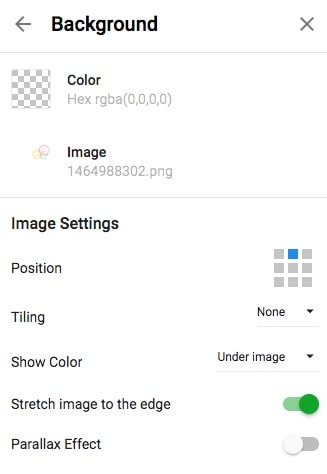
You can also choose the placement of the popup on the page, animate it or edit the overlay by using advanced settings.

Once you’re done with the customization, click next on the top right corner of the builder to bring the popup publishing wizard.
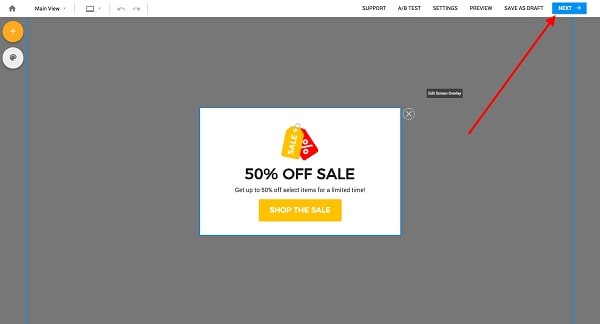
Step 3: Establishing Ground Rules
This is the technical step for establishing all targeting and trigger options for creating the pop-up, including the following aspects:
Name the popup for your future reference and mention the URL of the website where you want this pop-up to appear. If you wish to apply the campaign to specific pages instead of the whole website, tick “specific pages.”
From “More Display Options,” update the timing of the pop-up- whether you want it to appear at the start, exit, after ‘x’ seconds, or a specific scroll-up percentage. You can also update the impression frequency here, i.e., you can choose the number of times you want the ad to be shown to the same visitor.
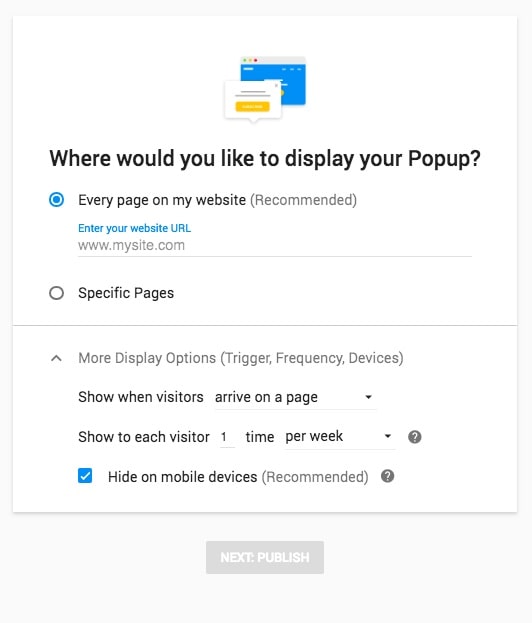
Step 4: Publish
After setting the trigger and frequency, click “Next: Publish,” and you’re all set.
If this is the first time you’re publishing the popup, make sure that the popup pixel code is installed on your website; otherwise, the popup won’t be displayed.

To do so, click on “<> get popup code” copy and paste it to the </head> tag in your website’s HTML segment.
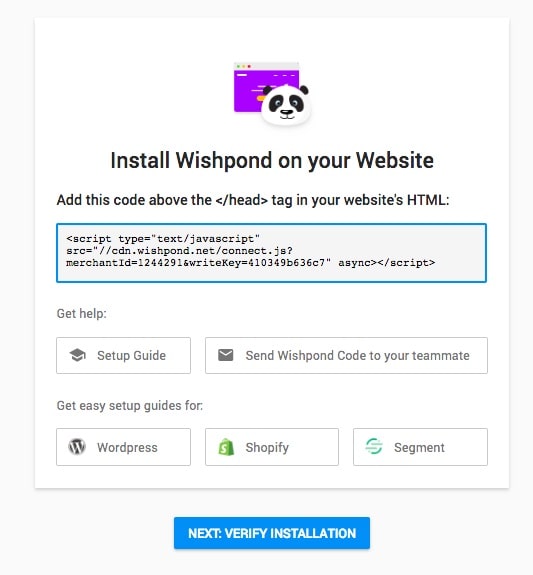
Best Practices for Creating Pop-up Ads That Convert
Casually using pop-up ads on websites could be a deal-breaker to your visitors. But, careful planning and intelligent implementation could score you a high conversion.
So, here are 5 bulletproof elements on how to make pop-up ads that are efficient.
1. Include visible closing options
Pop-up for the website surely highlights the message, but you need to respect the visitors who don’t want to indulge in it. And therefore, you need to keep it simple for them to close the ad or be annoyed (it will show in your conversion rate).
The best practice for how to create a popup is to keep the close button (“X”) in a visible range-preferably at the top right corner of the ad. We recommend using contrast colors as compared to the pop-up background. Alternatively, you can add a clickable closing line or button like “No Thanks, Continue Shopping” or “I am not interested” right below your CTA so that the visitor can easily see it.
Here’s an example from Contently with the close button clearly visible:
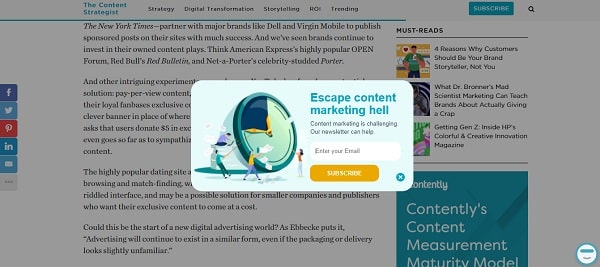
2. Create mobile-optimized campaigns
This is the one element that your pop-up must have!
Mobile traffic is as customary as desktop traffic, and your pop-up for a website must be primed for mobile viewing. Since there is a change in the screen space and limited space on mobile, the best practice is to shorten the copy, use smaller fonts and reduce the number of elements in the pop-up.
Google recommends that the mobile pop-up ad should not be bigger than 25% of the screen. So, don’t keep it bigger than 320px. The underlying idea is to optimize it such that it fits on the screen, and the user doesn’t have to scroll to view the entire pop-up. Additionally, you can check out Google’s policy on Interstitial ad guidance.
Bonus Tip: To avoid content congestion, don’t use more than two input fields in your mobile pop-up.

3. Frequency of Pop-up Ads
As discussed earlier, if you add a popup to a website, it could leverage frequency to achieve conversion. But if your pop-up triggers on every page or more frequently than it should during a browsing session, the users will walk out prematurely.
So what is the best frequency?
There is none, actually. But the thumb rule is never over-sell. So, limiting the frequency for pop-up ads on websites to 2 times during a browsing session or setting a limit on the number of days (for example, “show after every 7 days” or stop showing after 3 times) is the best approach to proceed with.

4. Test your pop-up’s UX
The ultimate aim of having a website with pop-up ads is to encourage the visitors to buy or at least subscribe and ensure maximum conversion. And a well-planned UX design of the pop-up can improve the overall user experience.
However, a good UX on your device doesn’t necessarily mean that the pop-up will appear the same way on other devices. Hence, it is necessary to test your pop-up’s UX design and screen resolution on different browsers, operating systems, and devices.
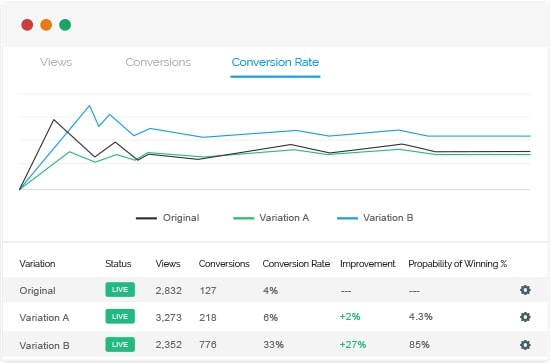
5. Choose the Right Pop-Up Ad Format
Pop-Ups can be classified on the basis of action (click, scroll, entry, and exit), placement (header, center, footer, and sidebar), and purpose (Subscription, discounts, and callback).
The best practice is to evaluate the underlying idea of the pop-up and choose a format that is best suited. For example, while click and scroll pop-ups are subtle, entry and exit pop-ups are bold and out there; while a sidebar pop-up is a small humble window on the side, a header or footer pop-up is clearly visible and cannot get unnoticed by the visitor.
Here’s how The New Yorker does it:
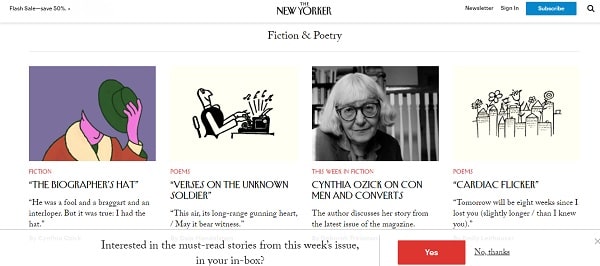
How to use different types of Pop-ups in accordance with the Best Practices
Pop-ups are not a “one for all” deal. They differ in size, type, format, navigation, and timing. And in order to avoid ad fatigue, it is recommended to vary the type of pop-ups. Here’s a lowdown of different types of pop-ups and how to create pop-up ads on websites that are best suited to your audience.
1. Click Pop-ups
These are not displayed to everybody, but only to those visitors who explicitly click on a designated text or image. The fact that visitors click on it first shows that they are interested; hence click pop-ups have the highest conversion rate as you get genuine leads directly from the interested visitors.
Here’s how you can do it
1. Via Text
Right after your blog’s title, place a clickable text promoting a free guide/manual on the topic related to the blog. Connect the click pop-up code to this link.
2. Via Image:
Place a banner at the start, middle, or bottom of your blog, promoting a free guide or offering visitors something and asking them to subscribe.
PTRs (Points to Remember)
- Use a clear CTA. Add actionable words like “download,” “Get,” “Want,” etc.
- Use the same heading in the pop-up as the CTA in the text/banner.
- Make your pop-up attractive, use contrasting colors and incorporate white space.
For example, Wishpond has used this banner in one of its blogs and asked the visitors to subscribe.
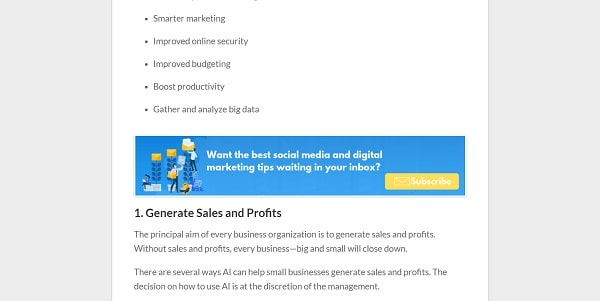
When a visitor clicks on subscribe, this pop-up appears instead of a new page. Notice how the heading of the pop-up is the same as the above CTA, “Subscribe Now” is written in contrasting yellow, and white space has been optimally incorporated.
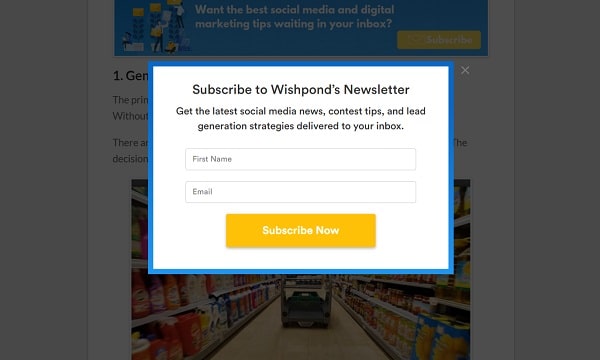
2. Scroll Pop-ups
These pop-ups are programmed to appear at a specific position on the page. They usually display when a visitor has scrolled down a certain percentage and reached a particular section or bottom of the page. The idea is to be sure that the visitor is provided with the targeted information when they are actually interested (not before, not after).
Here’s how you can use it-
- Choose the pop-up type as Scroll Pop-up and select whether you want to put it on a website page or blog.
- Set the scroll percentage as either 30% or 70% (most common for conversion)
- Limit the number of times each user sees the pop-up, preferably to 3 impressions per week.
For example
At a 70% scroll down on a travel website, a scrolling pop-up appears with the message “Sign up today and get a FREE travel itinerary for your favorite destination, totally customized for you.”
Setting it at 70% implies that the reader is interested in your page/blog. Offering him something of interest at this stage will probably result in a conversion. Further, at 70%, it is a high probability that those who might be uninterested in the pop-up will close it and continue reading the article, thus reducing the bounce rate.
A win-win situation, isn’t it?
3. Entry Popups
They pop as soon as a visitor lands on your website. So the first thing that a visitor sees is not your web page nor the services that you offer, but this pop-up.
So, are they risky? Yes!
Are they controversial? Yes
Do they generate conversion? A 100% yes, but you have to use them right.
Here’s how-
1. Run a lucrative promotion
Use words like “Exclusive Offer,” “Limited Time Only,” “Get 50% Discount”. Incorporate both options – either a sign-up/subscription or an option to skip the ad/close it. Remember how we talked about including a visible closing option (Link internally with Point 1. Under Best Practices for Creating Pop-up Ads That Convert)
For example,
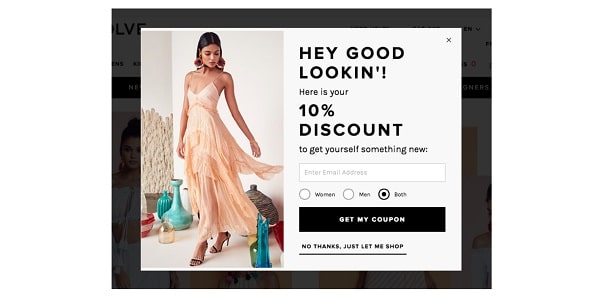
2. Address the Problem Area
Identify what your customers might be looking for and present them with something relatable.
For Example, a Wishpond Entry pop-up looks like this-
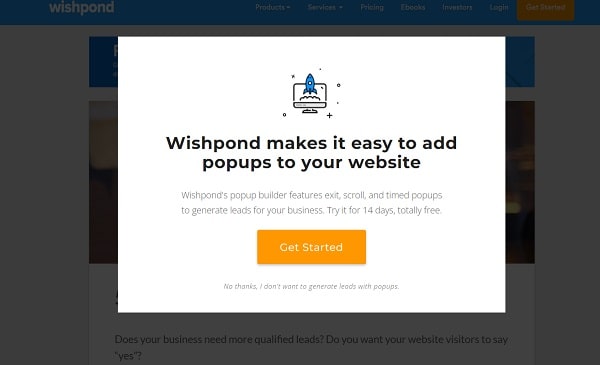
4. Exit Popups
Also called exit-intent, these pop-ups trigger when a visitor tries to leave your website or a page. The idea is to offer something that sweetens the pot and urges the visitor to stay.
Here’s how you can use it
Keep the exit pop-up relevant to the page of your website. Because once the visitor has made up his mind to leave the website, he’ll stay only when he’s offered something that interests him a lot.
For example
Wishpond uses the following exit popup when a visitor tries to leave its pricing page. Notice how the message is related to the pricing and tries to offer the visitor a session to decide further.
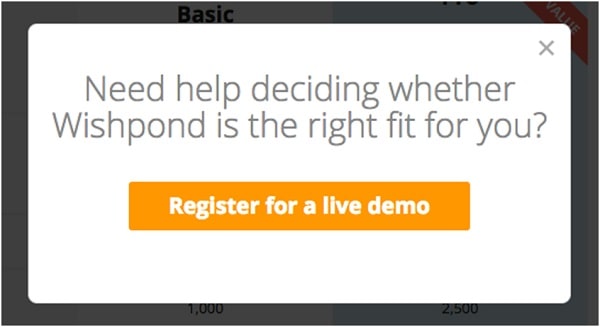
5. Video Popups
According to Wyzowl, 92% of marketers say that video popups are an important part of their marketing strategy. These are simple popups with embedded videos and could be used when you want to display a product explainer video or simply entertain your visitors.
Here’s how you can use it
You can set it to open on click, or otherwise, at entry or exit. Whatever mode you choose, write a heading that draws the visitor’s attention and keeps the video crisp and precise. Furthermore, put a button under the video so that the visitors can reach your product page.
By incorporating a well-executed video popup, you can expect a great deal of conversion. As per Lemonlight statistics for 2022, 94% of respondents shared that watching a video has helped them make a purchase decision at least once.
Related Content
- 5 Types of Popups to Use on Your Website
- Should I Use Popups?
- 33 All-Star Popup Examples and 5 BIG Lead Generation Takeaways
- 5 Examples of Website Popups that Work
- 6 Types of Popups: Use Cases that Won’t Frustrate Your Visitors
Key Takeaways
Pop-ups are controversial, but the well-executed ones are not, and they do work. They fortify your message, help penetrate new markets, capture leads, and increase sales.
Use an effective pop-up tool such as Wishpond to serve the most relevant content to website visitors at the right time. Such a tool can empower you to create well-targeted pop-ups ads that reduce cart abandonment, improve lead generation, and boost conversions. You simply need to create an account, choose and edit a template or create a design from scratch, specify trigger options, frequency, target audience, etc., and Voila! Your ad is ready to be published on your website.
Now, when you know how to create pop-up ads and the best practices to do so, all you need to do is comprehend the user’s potential requirements on your website, pick the right popup format to address them, and publish the ads.

Written by our guest writer Jared Cornwell, a customer support expert.
As a customer support specialist at ProProfs, he has been instrumental in developing complete customer support that has more than double customer satisfaction. You can connect and engage with Jared on LinkedIn.



